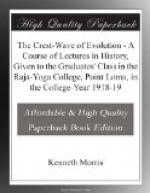The three elements are mingled beyond the wit of
man to unravel them; so that you can hardly tell whether
any given thing happened in this or that millennium,
Root-Race period, or Round of Worlds, or Day of Brahma.
You are in the wild jungles of fairyland; where there
are gorgeous blooms, and idylls, dreamlit, beautiful
and fantastical, all in the deep midwood lonliness;
and time is not, and the computations of chronology
are an insult to the spirit of your surroundings.
History, in India, was kept an esoteric science, and
esoteric all the ancient records remain now; and I
dare say any twice-born Brahmin not Oxfordized knows
far more about it than the best Max Mullers of the
west, and laughs at them quietly. Until someone
will voluntarily lift that veil of esotericism, the
speculations of western scholars will go for little.
Why it should be kept esoteric, one can only guess;
I think if it were known, the cycles and patterns
of human history would cease to be so abstruse and
hidden from us: we should know too much for
our present moral or spiritual status. As usual,
our own
savants are avid to dwarf all dates,
and bring everything within the scope of a few thousand
years; as for the native authorities, they simply
try confusions with us; if you should trust them too
literally, or some of them, events such as the Moslem
conquest will not take place for a few centuries yet.
They do not choose that their ancient history should
be known; so all things are in a hopeless muddle.
One thing to remember is this: it is a continent,
like Europe; not a country, like France. The
population is even more heterogeneous than that of
Europe. Only one sovereign, Aurangzeb —at
least for many thousands of years—was ever
even nominally master of the whole of it. There
are two main divisions, widely different: Hindustan
or Aryavarta, north of the Vindhya Mountains and the
River Nerbudda; and Dakshinapatha or the Deccan, the
peninsular part to the south. The former is the
land of the Aryans; the people of the latter are mainly
non-Aryan—a race called the Dravidians
whom, apparently, the Aryans conquered in Hindustan,
and assimilated; but whom in the Deccan, though they
have influenced them largely, and in part molded their
religion, they never quite conquered or supplanted.
Well; never is a long day; dear knows what may have
happened in the long ages of pre-history.
The Aryans came down into India through its one open
door—that in the northwest. But when?—Oh,
from about 1400 to 1200 B.C., says western scholarship;
which has spent too much ingenuity altogether over
discovering the original seat of the Aryans, and their
primal civilization. After Sir William Jones
and others had introduce Sanskrit to western notice,
and its affinity had been discovered to that whole
chain of languages which is sometimes called Indo-European,
the theory long held that Sanskrit was the parent
of all these tongues, and that all their speakers




